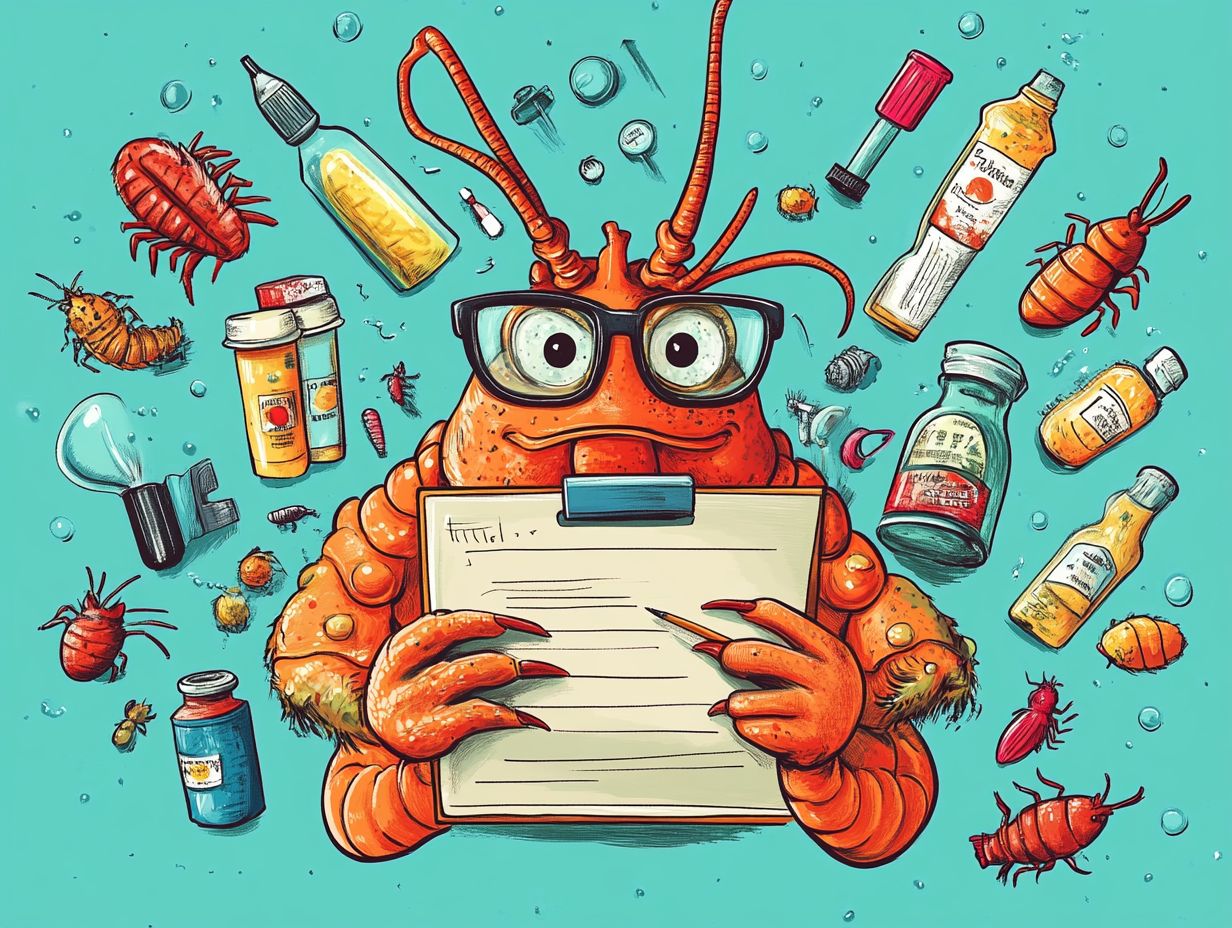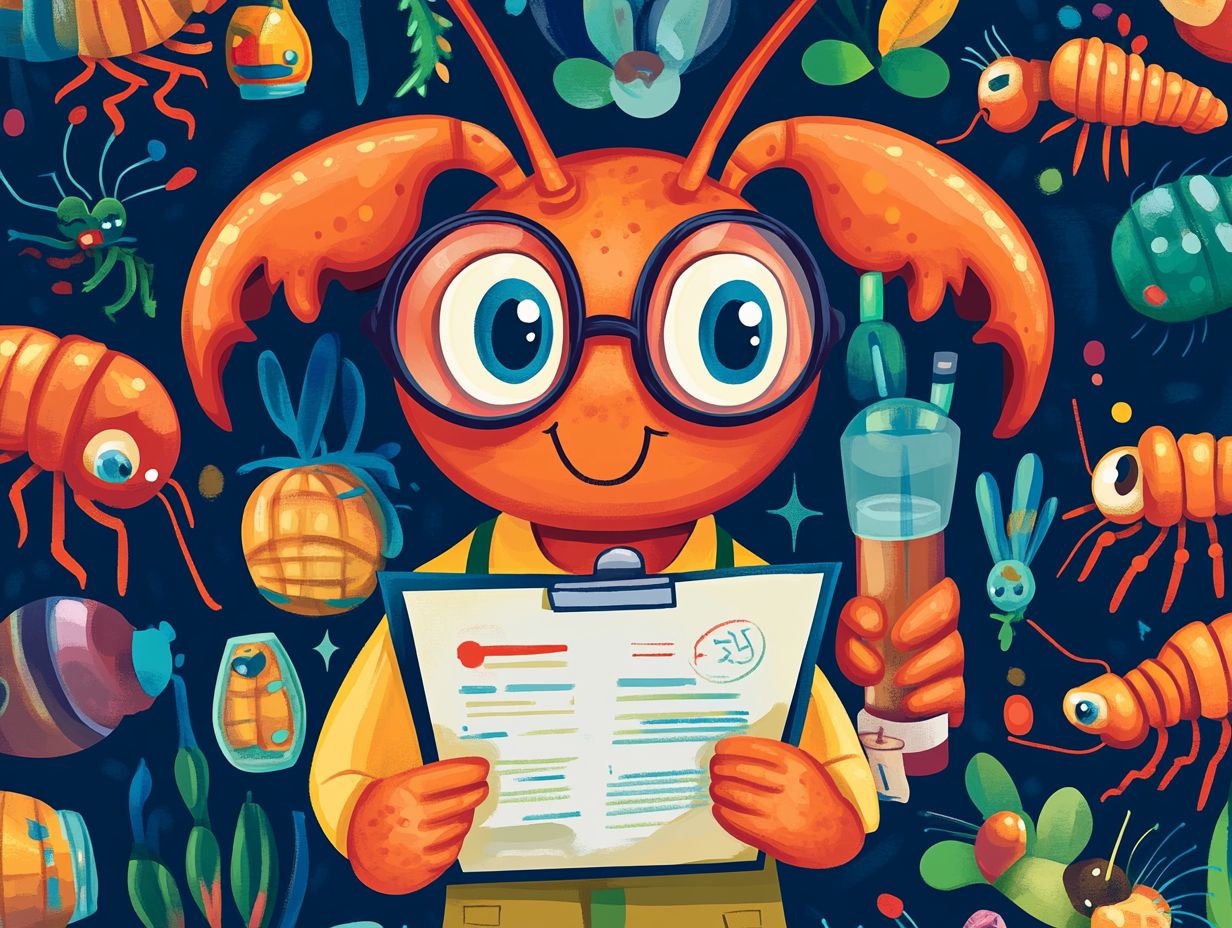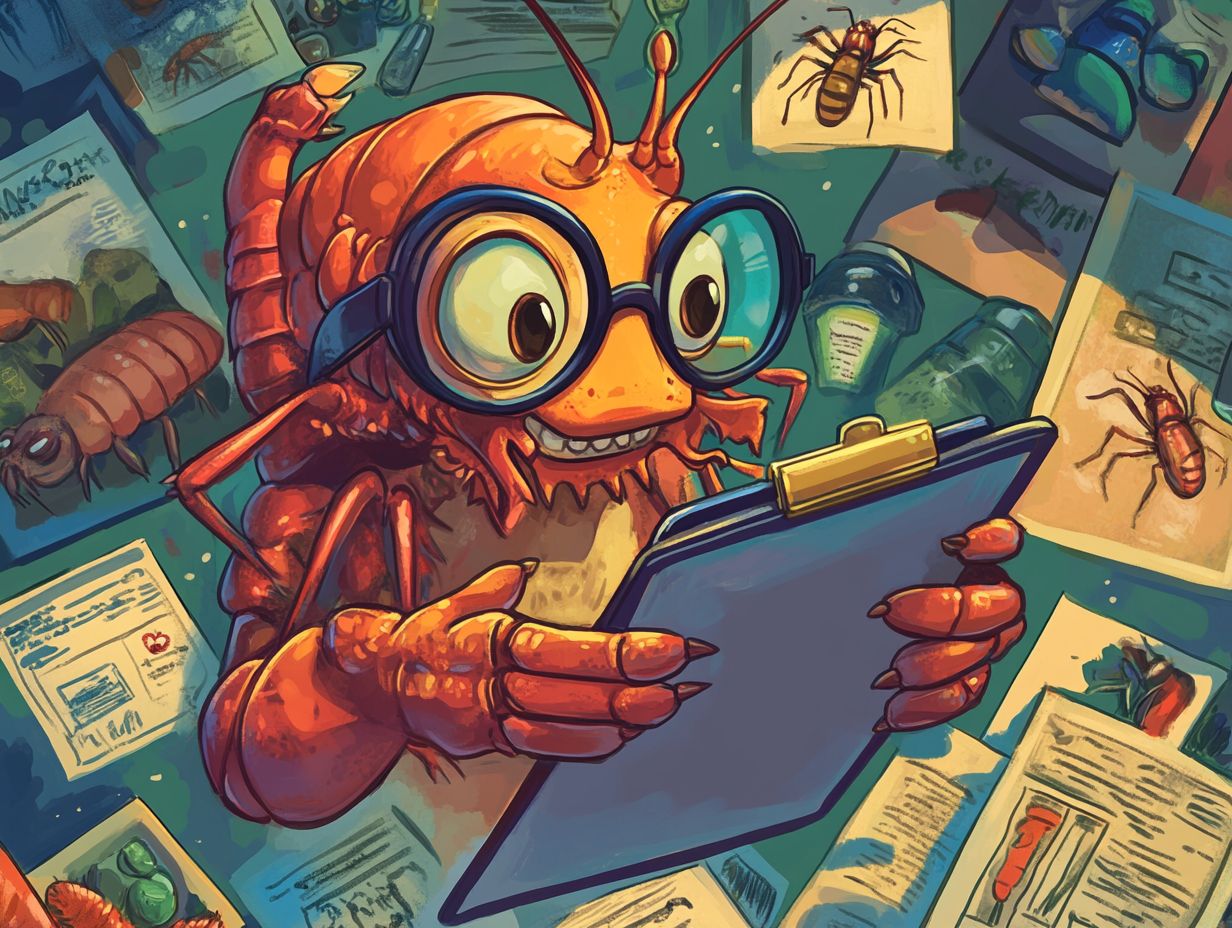In an innovative twist on pest management, you might want to check out Lobster Marketing Pest Control. It’s a unique solution that combines environmental consciousness with effective pest control strategies.
This approach has some key components that offer great benefits, like cost-effectiveness and long-term sustainability. However, it's not all sunshine and rainbows; there are also challenges to consider, such as potential risks and regulatory considerations.
Take a moment to discover how Lobster Marketing Pest Control can be utilized in agriculture and seamlessly integrated into effective marketing strategies.
What Is Lobster Marketing Pest Control?

Lobster Marketing Pest Control is all about mixing the promotion of lobster products with smart pest management techniques designed specifically for the seafood industry. This fresh approach aims to raise consumer awareness about the lobster industry while making sure that the seafood products you sell are both sustainable and safe.
By using integrated pest management, you can protect your harvests and guarantee that your customers get top-notch lobster. Plus, it helps you stick to environmental standards and food safety regulations. Balancing marketing and pest control is crucial if you want to thrive in today’s competitive seafood market.
How Does Lobster Marketing Pest Control Work?
Lobster Marketing Pest Control combines effective marketing strategies with innovative pest management practices to optimize both lobster quality and consumer engagement.
You can use various marketing channels, like social media marketing and seafood advertising, to connect with your target audience while also implementing pest control products and methods to ensure a safe and sustainable lobster supply.
By blending these approaches, you can manage pests effectively while promoting your products and strengthening your brand position in the seafood trade.
What Are the Main Components of Lobster Marketing Pest Control?
The main components of Lobster Marketing Pest Control are all about pest identification, treatment methods, and effective marketing analytics that tap into consumer demographics. By getting a grip on the specific challenges in the lobster industry, you can apply targeted pest control measures while also boosting your marketing efforts to connect with potential customers.
This holistic approach not only ensures a sustainable lobster supply but also helps improve brand awareness and customer loyalty through well-crafted promotional materials and product labeling.
To kick things off, pest identification means more than just spotting the pests that threaten lobster populations, like mites or sea lice. It’s also about understanding their life cycles and behaviors. This knowledge makes it possible for you to implement precise treatment methods that can range from organic solutions to more traditional pesticides.
When you leverage marketing analytics, you can track consumer trends and tweak your strategies to stay competitive in a busy market. Plus, analyzing what your competitors are doing can help you figure out the best channels to reach your target audience, opening doors for engagement and sales that align with changing consumer preferences.
What Are the Benefits of Using Lobster Marketing Pest Control?
Using Lobster Marketing Pest Control comes with a bunch of benefits that are both eco-friendly and financially savvy, making it a smart choice for your seafood business. By promoting environmentally friendly pest management solutions, you can elevate your brand image while also cutting down on your environmental footprint.
Plus, these cost-effective strategies help keep your operational costs low, allowing you to offer better pricing while still delivering top-notch lobster products. This integrated approach not only raises consumer awareness but also supports sustainable fishing practices, which are crucial in today’s conscientious market.
1. Environmentally Friendly
One major benefit of Lobster Marketing Pest Control is its focus on environmentally friendly practices that promote sustainable fishing and organic pest control methods. By prioritizing eco-friendly solutions, you can significantly reduce your environmental impact while ensuring food safety standards are met for your lobster products. This approach doesn’t just align with consumer trends favoring sustainability; it also enhances the overall reputation of the lobster industry, making it much more appealing to conscientious consumers.
By utilizing organic pest control methods like biological control agents and natural repellents, you can effectively manage pest populations without relying on synthetic chemicals. For example, introducing beneficial insects helps keep harmful pests in check, protecting your lobster stocks from potential threats. Plus, implementing practices like crop rotation and habitat restoration not only improves pest management but also contributes to the overall health of marine ecosystems.
By adopting these sustainable strategies, you can show your commitment to preserving biodiversity while producing high-quality seafood that meets modern consumer demands for safe and responsibly sourced products.
2. Cost-effective
One major perk of Lobster Marketing Pest Control is how cost-effective it is, helping you keep expenses in check while efficiently meeting market demand. By using smart pest management techniques, you can cut down on losses caused by pests and improve your inventory management. This, in turn, allows you to offer better competitive pricing for your lobster products. It’s a win-win for both you and your customers—affordability without skimping on quality.
Keeping a pest-free environment also boosts your reputation among buyers, which encourages loyalty and repeat purchases. This integrated approach not only slashes operational costs but also aligns with the growing consumer demand for sustainably sourced seafood, giving your profitability a nice little boost.
As customers increasingly look for businesses that show they care about the environment, you can take advantage of this trend by employing effective pest control strategies. Ultimately, the link between efficient pest management and financial gain is pretty clear; it sets you up with a solid business model that focuses on both quality and cost savings.
3. Targeted Pest Control

One of the great benefits of Lobster Marketing Pest Control is your ability to use targeted pest control measures that are tailored to specific pest lifecycles and behaviors. By really understanding the pest lifecycle, you can implement precise treatment methods that effectively reduce risks without putting the lobster harvest in jeopardy. This targeted approach doesn't just improve pest management outcomes; it also syncs up perfectly with your marketing efforts to highlight the quality and safety of your lobster products.
Using these advanced strategies can significantly cut down on your reliance on broad-spectrum pesticides, which can be a hazard for both the environment and the lobster population. By regularly assessing pest populations and analyzing data related to their lifecycle, you can apply intervention strategies that are timely and efficient.
For example, knowing when pests are most vulnerable lets you implement preventative measures, which helps reduce overall pest pressure in lobster habitats. This nuanced understanding also comes in handy when you're crafting marketing narratives that resonate with consumers, showcasing your commitment to sustainable practices while assuring them that they're getting the best quality seafood.
4. Long-term Solution
Implementing Lobster Marketing Pest Control is your ticket to a long-term solution if you're looking to sustain your lobster fisheries while building brand loyalty among consumers. By mixing pest management with smart marketing strategies, you can ensure a steady supply of quality lobster, which helps build consumer trust and encourages those repeat purchases. This approach not only helps you expand your market but also supports the overall health of the lobster industry through sustainable practices.
This strategic integration highlights how crucial responsible fishing methods are. You’ll minimize environmental impact while maximizing your yield. As you embrace these sustainable practices, you're not just adhering to industry regulations; you're also meeting the growing consumer demand for ethically sourced seafood. This commitment to sustainability reinforces brand loyalty because customers increasingly want to back companies that prioritize responsible sourcing.
In the end, this creates a positive brand image that resonates with eco-conscious buyers, significantly boosting your long-term market success and ensuring the preservation of marine resources for future generations.
What Are the Risks of Using Lobster Marketing Pest Control?
While Lobster Marketing Pest Control comes with a bunch of benefits, there are some risks you need to keep in mind. You might face potential harm to other marine life, and some pest control methods may not be as effective as you'd hope.
Because of these challenges, it’s essential for you to carefully assess and implement pest prevention strategies. This way, you can steer clear of any unintended consequences that could hurt the lobster industry and your marketing efforts.
1. Potential Harm to Other Marine Life
One critical risk you face when using Lobster Marketing Pest Control is the potential harm it might cause to other marine life if certain pest control products are applied incorrectly. This could disrupt the delicate ecological balance in lobster habitats, leading to some pretty unintended consequences that could affect not just the lobster population but the entire marine ecosystem.
The adverse effects might include a decline in populations of non-target species like fish and crustaceans, which are crucial for maintaining healthy marine environments. For example, if beneficial organisms die off, you could see increased algal blooms that further degrade water quality and impact all forms of marine life.
That’s why it’s essential for anyone involved in lobster harvesting to adopt integrated pest management strategies. By prioritizing the use of less harmful alternatives while still getting effective pest control, you can play a part in protecting marine biodiversity. Responsible application of these products is key to safeguarding the ocean’s resources, which ultimately supports your livelihood and those of others who depend on it.
2. Limited Effectiveness on Certain Pests
Another major concern you might want to keep in mind is that some pest control methods just don’t cut it for specific pests, especially when those pests have lifecycles that allow them to resist treatment. This resistance can cause pest populations to swell, which could seriously affect the quality of lobsters and the market supply if it's not handled properly.
The complexities of pest lifecycles often help them adapt, making traditional treatments fall short. Take, for example, pests that reproduce quickly or go through multiple life stages; they can easily tough it out against chemical applications aimed at taking them out.
As a result, the lobster industry can face rising costs since producers might need to invest in more robust—and likely pricier—pest control strategies. When treatments don’t work, you end up with subpar lobsters that don’t meet market standards, which can damage consumer trust and lower demand.
To succeed in lobster marketing, it’s essential to focus not just on the quality of the product, but also on effective pest management that tackles these challenges head-on.
How Can Lobster Marketing Pest Control Be Used in the Agriculture Industry?
You can also use Lobster Marketing Pest Control effectively in the agriculture industry by applying its principles to manage pests that threaten your crops and livestock. By connecting the practices of lobster aquaculture to broader agricultural pest management strategies, you can enhance the sustainability of your food sources.
Plus, this approach fits perfectly with the growing consumer demand for integrated pest management solutions across various sectors.
1. Controlling Pests in Crops

Effective pest control in your crops is key to maximizing yield and ensuring sustainable agricultural practices, and you can leverage Lobster Marketing Pest Control principles to get there. By understanding pest resistance and implementing targeted strategies, you can protect your crops while promoting sustainable farming methods that resonate with today’s consumers.
Integrating these principles means regularly monitoring pest populations, which helps you make informed decisions about when and how to intervene. Adopting integrated pest management (IPM) systems can enhance your crop resilience by using natural predators and biopesticides, all while aligning with eco-friendly practices.
You can also focus on crop diversity and rotation to disrupt pest life cycles, giving your defenses against infestations an extra boost. By emphasizing these sustainable approaches, you’ll not only help preserve the agricultural ecosystem but also enhance the overall health and profitability of your farm, meeting both market demands and environmental responsibilities.
2. Protecting Livestock from Pests
Protecting your livestock from pests is super important for keeping them healthy and productive, and the strategies you can find in Lobster Marketing Pest Control can really help with that. By using integrated pest management techniques, you can keep those pesky pests at bay while sticking to sustainable farming and food safety standards.
Effective pest management not only cuts down on the risk of disease transmission but also boosts the overall health of your herd. This can lead to better growth rates and higher yields of animal products, which is always a win. By putting in place preventative measures and keeping an eye on things, you can minimize infestations and create a more stable environment for your animals.
The principles from Lobster Marketing Pest Control highlight the importance of a comprehensive approach that combines biological, mechanical, and chemical strategies. This makes it easier for you to maintain your animals' welfare while also meeting market demands. Ultimately, adopting a proactive control strategy not only protects your livestock but also supports sustainable agricultural practices.
What Are the Regulations Surrounding the Use of Lobster Marketing Pest Control?
In terms of Lobster Marketing Pest Control, you need to keep in mind a bunch of regulations that cover pest control practices and seafood safety standards. These rules are essential for making sure consumers stay safe and that the lobster industry operates sustainably.
Following these guidelines means your pest management methods will be in line with health regulations and environmental concerns, which helps promote a responsible seafood trade.
How Can Lobster Marketing Pest Control Be Implemented in a Marketing Strategy?
When you’re looking to implement Lobster Marketing Pest Control into your marketing strategy, start by identifying your target audience. Tailor your messaging to connect with what matters to them, focusing on quality and sustainability.
By using social media marketing and engaging with your customers, you can effectively highlight the benefits of your pest management practices while also showcasing your lobster products to a broader audience.
1. Identifying Target Audience
Identifying your target audience is a crucial step when implementing Lobster Marketing Pest Control. When you understand the demographics of your potential customers, you can tailor your marketing efforts to engage them more effectively. By diving into some thorough market research, you can align your seafood advertising strategies with what your audience values and prefers, which will boost overall engagement.
Start by recognizing key consumer trends like geographic location, age, and income level, since these factors directly impact purchasing decisions. Analyzing your competitors and gathering insights through surveys or focus groups can provide valuable information about what motivates your potential buyers.
It’s also vital to keep your finger on the pulse of evolving market preferences because these can change with economic shifts or new consumer interests. By leveraging this information, Lobster Marketing Pest Control can create personalized advertising campaigns that truly resonate with your audience, making it easier to attract and retain customers.
2. Creating Effective Messaging
Creating effective messaging is crucial for your success with Lobster Marketing Pest Control. It positions your brand in a competitive market and helps build customer loyalty. By crafting promotional materials that highlight the benefits of sustainable practices and quality assurance, you can really connect with consumers and set yourself apart from the competition.
To strengthen that connection with potential clients, you should definitely weave in some storytelling elements that showcase your brand's values and mission. Today’s consumers are increasingly attracted to companies that are authentic and align with their beliefs, so it's important for you to clearly express your commitment to environmentally friendly solutions.
Don't forget to leverage social proof through testimonials and case studies. This can really boost your credibility and help keep your current customers loyal while also attracting new ones. When your messaging aligns with what users need, you create a sense of community, fostering lasting relationships that go beyond just transactions.
3. Measuring Success and Making Adjustments

Measuring success is crucial for your ongoing Lobster Marketing Pest Control initiatives. It helps you evaluate how effective your marketing campaigns really are and make any necessary adjustments along the way.
By utilizing marketing analytics and customer feedback, you can refine your strategies to better meet the needs of your audience while aligning with your pest management goals.
This whole process not only lets you see which strategies are hitting the mark but also highlights areas that might need a bit more love and attention. By incorporating metrics like customer engagement rates, conversion stats, and return on investment, you can get a clearer picture of how your campaigns are performing.
Plus, using feedback mechanisms like surveys and social media interactions gives you direct insights from your customers, creating that essential two-way communication in today’s competitive landscape.
Ultimately, these tools give the power to you to adjust your marketing efforts proactively, making sure you stay effective and relevant in tackling the challenges that come with pest control.
Frequently Asked Questions
What is lobster marketing pest control?
Lobster marketing pest control refers to the methods and strategies used to manage and eliminate pest infestations in the lobster industry. This can include techniques such as bait and trap management, use of natural predators, and proper storage and handling practices.
Why is pest control important in lobster marketing?
Pest control is crucial in lobster marketing to ensure the quality and safety of the product. Pests can cause damage to lobsters, leading to losses for businesses and potential health hazards for consumers. Effective pest control measures help maintain the integrity of the lobster industry and protect both producers and consumers.
What are some common pests in the lobster industry?
Some common pests in the lobster industry include marine borers, crabs, sea lice, and various types of parasites. These pests can cause damage to lobsters during storage and transportation, and can also affect their overall health and quality.
How can I prevent pests from infesting my lobster stock?
Prevention is key in pest control for lobster marketing. Some effective measures include proper storage and handling practices, regular cleaning and maintenance of traps and equipment, and use of bait and trap management techniques. It is also important to closely monitor the lobster stock and address any signs of infestation immediately.
Are there any eco-friendly pest control methods for the lobster industry?
Yes, there are eco-friendly pest control methods that can be used in the lobster industry. These include the use of natural predators, such as certain types of fish or birds, to control pest populations. Additionally, implementing sustainable fishing practices can help maintain a healthy balance in the marine ecosystem and reduce the risk of pest infestations.
Should I hire a professional pest control service for my lobster business?
It is highly recommended to hire a professional pest control service for your lobster business. They have the expertise and experience to effectively identify and address pest issues, as well as provide ongoing monitoring and prevention strategies. This can help save time, money, and ensure the success of your lobster marketing efforts.

